ISSN
2307–3489 (Print), ІSSN
2307–6666
(Online)
Наука
та прогрес транспорту. Вісник
Дніпропетровського
національного університету залізничного
транспорту, 2019, № 4 (82)
ЕКОЛОГІЯ
ТА ПРОМИСЛОВА БЕЗПЕКА
UDC
519.872:[504.5:622.807]
V. V.
BILIAIEVa1*,
P. S. kirichenko2*,
O. V.
Berlov3*,
V. O.
gabrinets4*,
V. M. Horiachkin5*
1*Dep.
«Aerohydrodynamics and Energy
Mass-transfer», Oles Honchar Dnipro
National
University, Haharina Av., 72, Dnipro, Ukraine, 49000, tel.
+38 (056) 374 98 22,
e-mail water.supply.treatment@gmail.com ORCID
0000-0003-2399-3124
2*Dep.
«Heat and Gas Supply, Drainage and Ventilation», Kryvyi Rih
National University,
Vitaliia Matusevycha St., 11, Kryvyi Rih,
Ukraine, 50027, tel. +38 (056) 409 06 06,
e-mail pasha_129@ukr.net,
ORCID 0000-0002-0793-9593
3*Dep.
«Life Safety», Prydniprovsk State Academy of Civil Engineering
and Architecture,
Chernyshevskoho St., 24а, Dnipro,
Ukraine, 49600,
tel. +38 (056) 756 34 57
e-mail
berlov@pgasa.dp.ua, ORCID 0000-0002-7442-0548
4*Dep.
«Heat Engineering», Dnipro National University of Railway Transport
named after Academician V. Lazaryan, Lazaryan St., 2, Dnipro,
Ukraine, 49010,
tel. +38 (056) 373 15 87, e-mail gabrin62@gmail.com,
ORCID 0000-0002-6115-7162
5*Dep.
«Heat Engineering», Dnipro National University of Railway Transport
named
after Academician V. Lazaryan, Lazaryan St., 2, Dnipro,
Ukraine, 49010,
tel. +38 (056) 373 15 87, e-mail vgora@ukr.net,ORCID
0000-0002-8952-952X
COMPUTER MODELING
OF AIR POLLUTION
IN CASE OF DUST CLOUD MOVEMENT
IN OPEN PIT MINE
Purpose. Explosions in open pits lead to the
formation of dust clouds. These clouds lead to intense air pollution.
An important task is the development of methods for predicting the
dynamics of atmospheric air pollution during explosions in open pits.
The purpose of this work is development of a numerical model to
predict atmosphere pollution after explosion in open mine pit. The
task is to develop a numerical model that would allow for the
calculation to take into account the geometrical shape of the open
pit mine, the parameters of the meteorological situation (wind speed,
atmosphere), the shape of the dust cloud that is formed in the open
pit mine at the site of the explosion. Methodology.
Mathematical modeling of dust cloud dispersion during an
explosion in an open pit mine is based on the use of fundamental
equations of aerodynamics and mass transfer. The airflow velocity
field in the open pit mine is modeled using the Laplace equation for
the velocity potential. The formation of the concentration field of
dust is modeled on the basis of the equation of convective-diffusion
dispersion of an impurity. For numerical integration of modeling
equations, difference schemes are used. The Laplace equation for the
velocity potential is numerically integrated using the Richardson
method. For the numerical integration of the convective-diffusion
dispersion equation for an impurity, an implicit difference splitting
scheme is used. Findings. A CFD model has been developed that
allows you to calculate the formation of pollution zones during the
movement of a dust cloud in the open pit mine. A feature of the
developed model is the speed of calculation. For practical use of the
developed model, standard input information is required. Originality.
In contrast to the existing models in Ukraine, the developed
numerical model allows taking into account the geometrical shape of
the open pit mine and the geometrical shape of the dust cloud when
making predictive calculations to assess the level of air pollution
caused by explosions in open pits. Practical value. The
developed numerical model can be implemented on computers of low and
medium power. For practical use of the numerical model, standard
information on meteorological conditions in open pit mine is
required. The numerical model can be used for environmental
assessment of the effect of explosions in open pit mine on
environmental pollution and work areas.
Keywords:
dust cloud; open pit mine;
atmosphere pollution;
computer simulation
Introduction
Explosions
in open pit mine yield in large amount of different pollutants
emission into the atmosphere [3].
Assessment of risk as a result of air pollution in case of such
emissions or others at the different enterprises is of great
interest [1,2, 4, 5, 11, 14, 15]. Under the influence of atmospheric
diffusion and wind flow, dust clouds are removed from the pit.
During explosions in the open pit mines, the territory adjacent to
the open pit mine is contaminated. An important problem is
prediction of air pollution after explosions in an open pit mine. In
Ukraine, at present, the OND-86 method is used to predict the
process of atmospheric pollution during explosions in open pit mine.
However, this technique has a number of
significant drawbacks. It does not take into account the geometric
shape of the open pit mine, the wind velocity profile, and
atmospheric diffusion.
In this regard, the urgent task
is to create efficient numerical models for analyzing the effects of
emissions on atmospheric pollution. The use of numerical models,
commercial codes like ANSYS® for the prediction of air pollution
requires the use of powerful computers and much computer time [7, 8,
12, 13]. For practice, it is important to have numerical models that
would take into account the main physical factors influencing the
formation of contaminated areas, and on the other hand could be
quickly implemented on computers of low and medium power [2, 4, 5].
Purpose
The aim of
the work is to develop an efficient, fast computing numerical model
for prediction of dust cloud dispersion after explosion in open pit
mine.
Methodology
As it is known, the application
of the Navier-Stokes equations to calculate the wind flow in open
pit mine takes computing time. The calculation may take several
days. Therefore, to create a fast-calculating computer model, the
inviscid fluid model will be used.
Modeling
equations. Introducing the assumption
that airflow is potential, the basic equation of aerodynamics has
the form [6, 9, 10]:
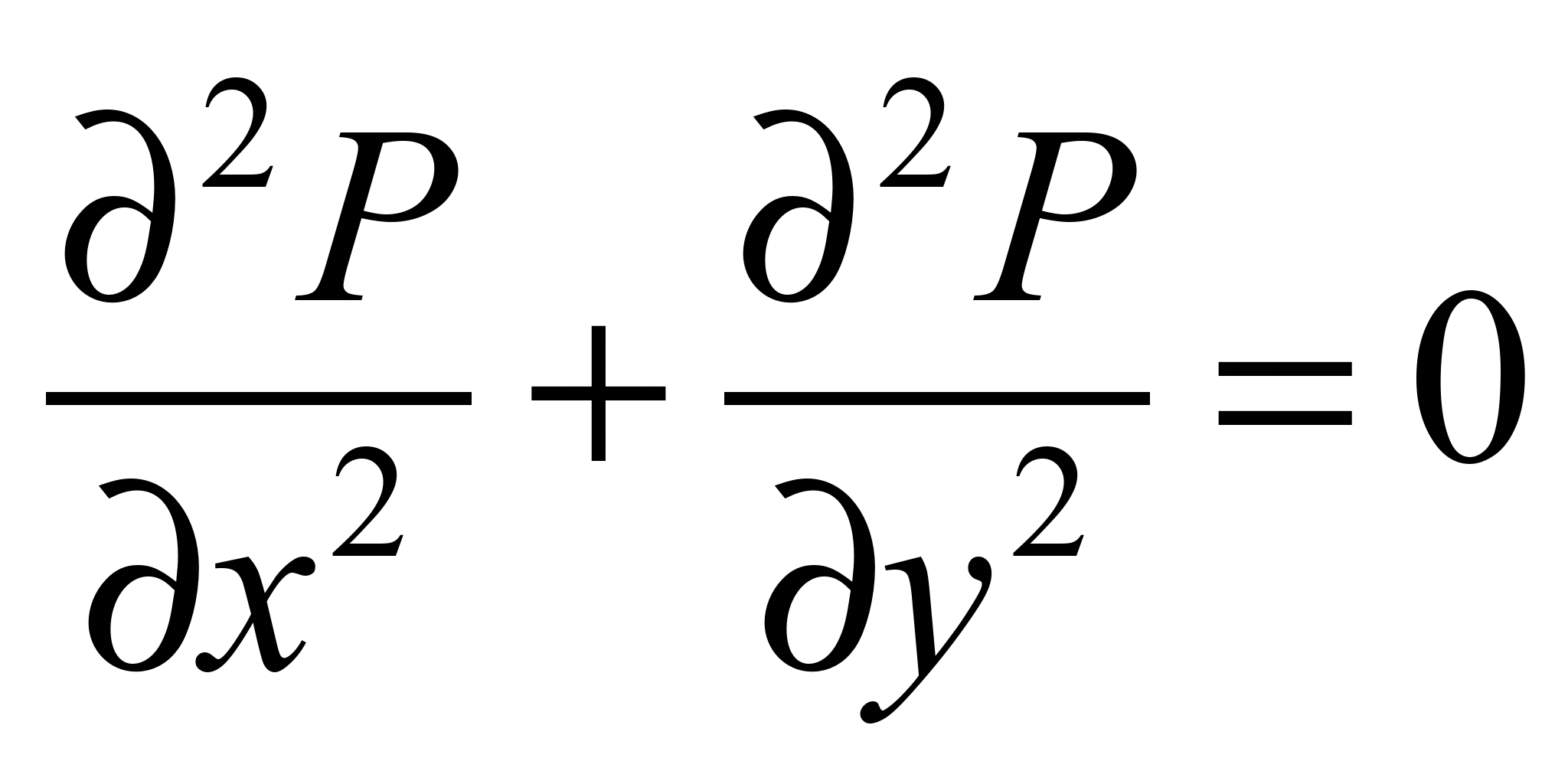 , (1)
, (1)
where Р
– is velocity potential, x,
y – are
Cortesian coordinates, m.
When applying this equation, it
is assumed that the Y axis is directed vertically upwards.
To solve the
equation (1) the following boundary conditions are used [6]:
1) on
the walls of the open pit mine, as well as on other solid surfaces
located inside it, a following boundary condition is set:
P/n = 0,
where n –
is unit vector of external normal to solid
wall;
2) at
the inlet
boundary we set: P/n = Vn,
where Vn
– known airflow velocity, m·s-1;
3) at
the outlet boundary we set: P = P0 +const,
P0
– is arbitrary number
(Dirichlet condition).
To simulate the dispersion of
dust in open pit mine, the mass transfer equation (Marchuk equation)
is used [6, 9, 10]:

 (2)
(2)
where С
– is dust concentration
in the
atmosphere, g·m-3;
u, v
– are wind flow velocity
components, m·s-1;
ws
– is dust fallout speed, m·s-1;
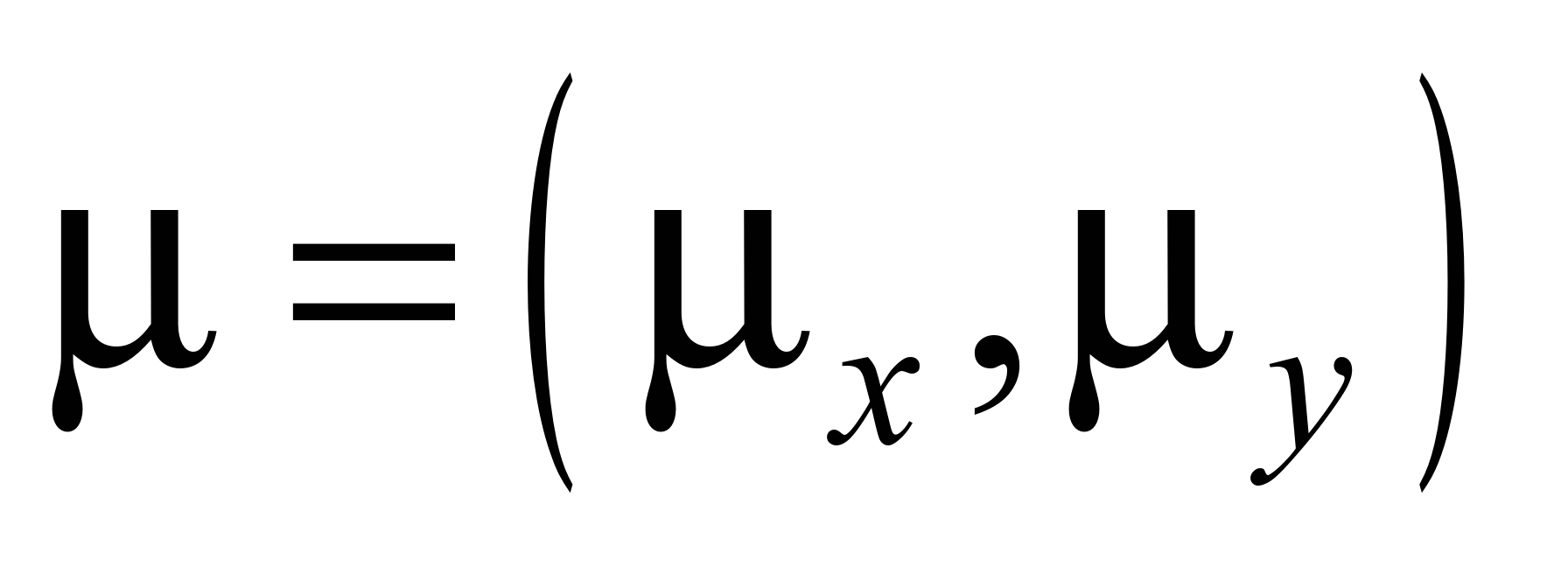 – are turbulent
diffusion
coefficients, m2·s-1,
x, y
– are Cortesian coordinates, m; σ – coefficient of pollutant
chemical decay, s-1.
– are turbulent
diffusion
coefficients, m2·s-1,
x, y
– are Cortesian coordinates, m; σ – coefficient of pollutant
chemical decay, s-1.
Initial and
boundary conditions for (2) are discussed in [6].
Numerical model. Numerical
integration of modeling equations is carried out using a rectangular
difference grid.
Convective derivatives are
represented as [6]:
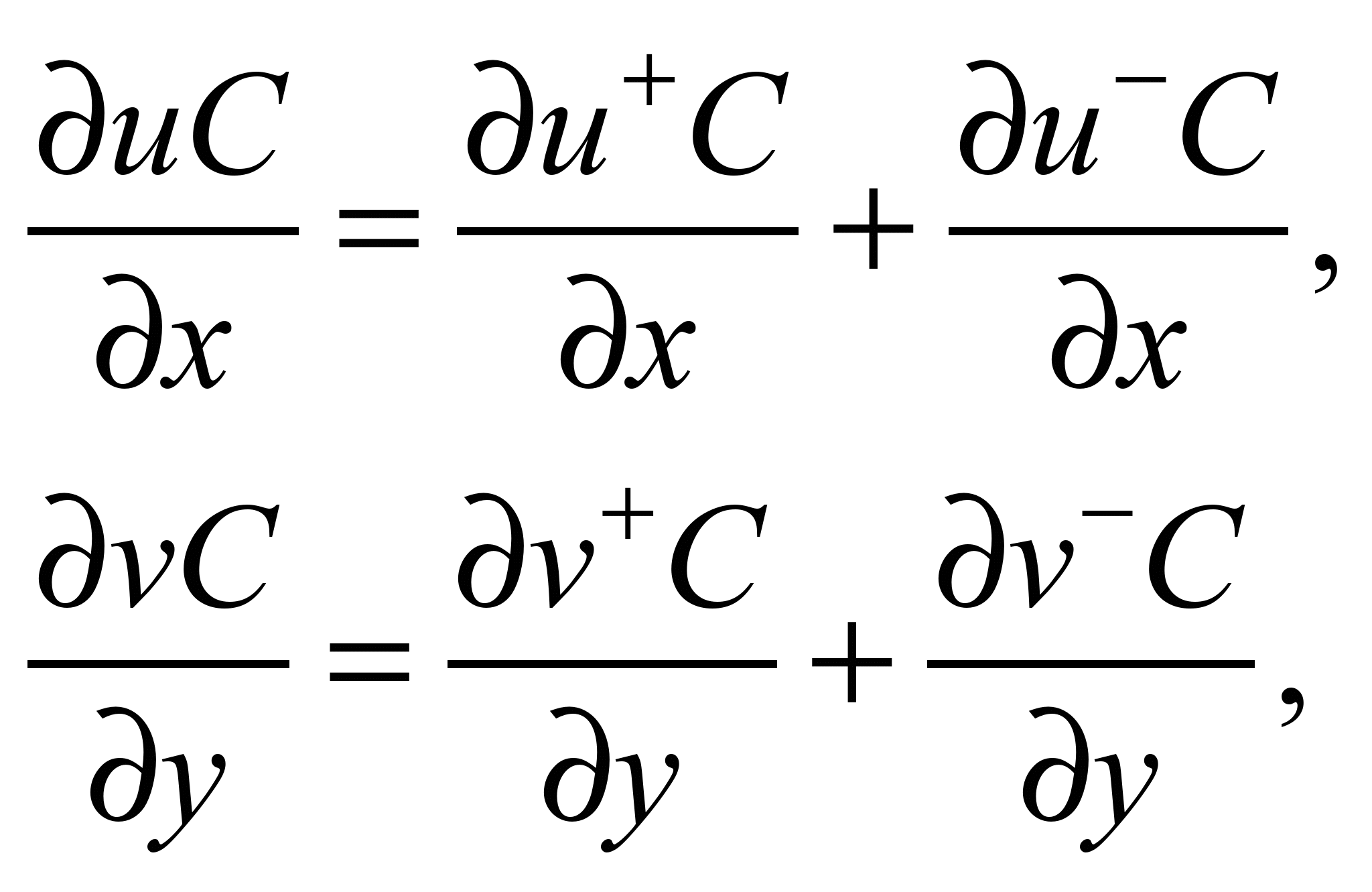
where

The
approximation of these derivatives is carried out according to the
formulas [6]:
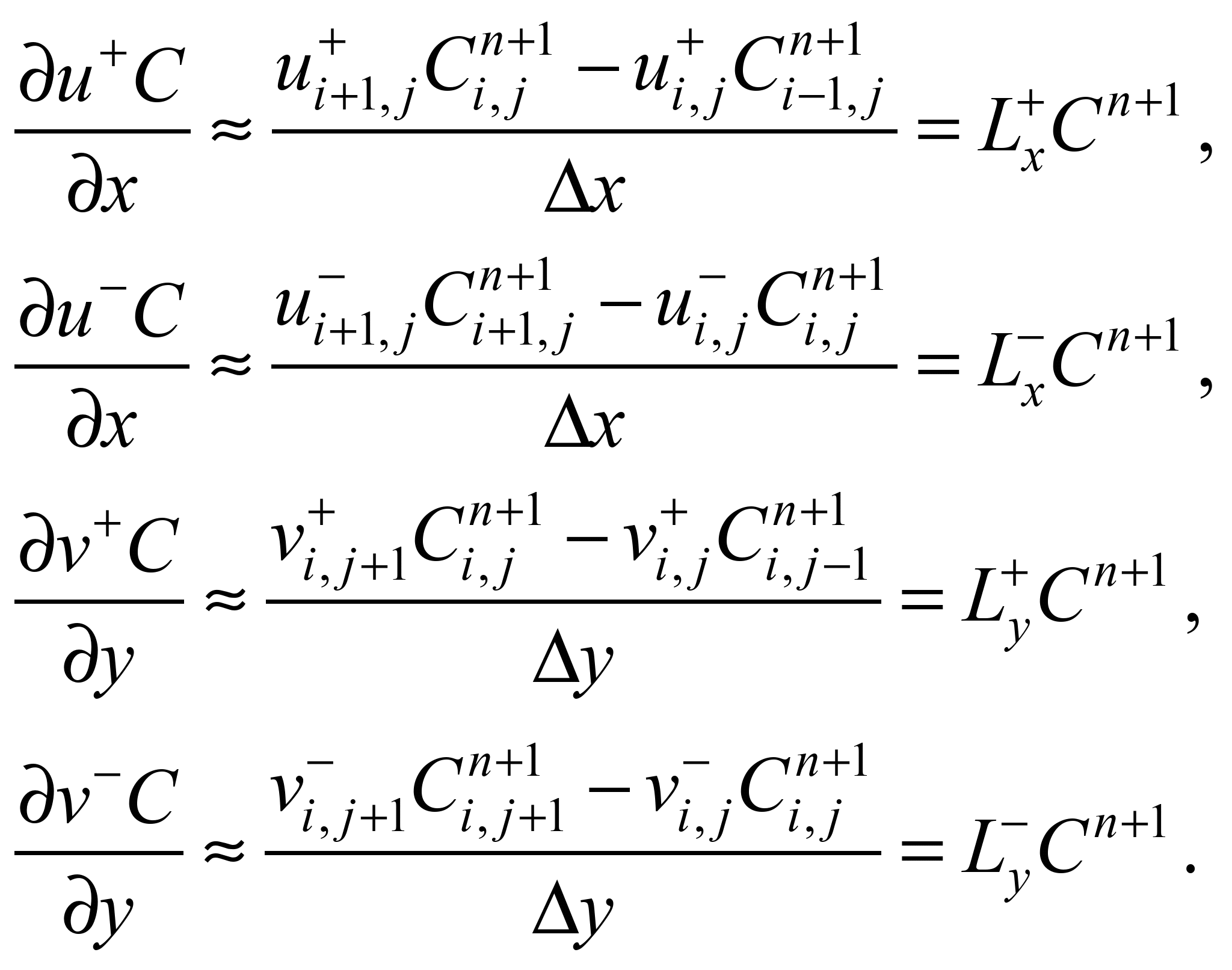
The time derivative is
approximated as follows:
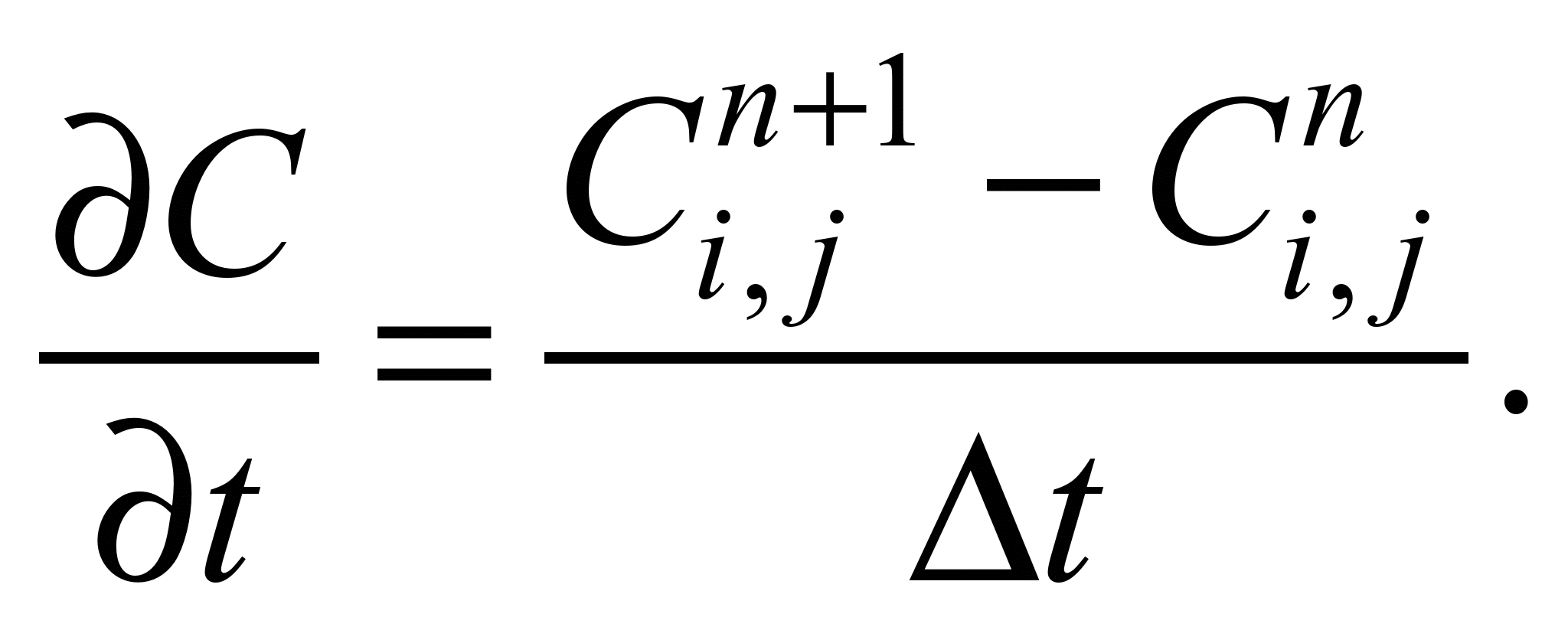
To approximate the second
derivatives, the following formulas are used [5]:




Taking into account the above
notation for difference operators, the original mass transfer
equation is represented as:



Further, splitting of this
difference equation is carried out as following:
1) on the first step of
splitting (k = n+1/4) the difference equation has the
appearance:

 (3)
(3)
2) on the second step of
splitting (k = n+1/2; c = n+1/4) the difference
equation has the appearance:

 (4)
(4)
3) on the third step of
splitting (k = n+3/4; c = n+1/2) the equation
(4) is used;
4) on the fourth step of
splitting (k = n+1; c = n+3/4) the equation (3)
is used.
From equations (3) and (4) the
unknown value of the dust concentration is calculated by explicit
formula of running calculation.
For the
numerical integration of velocity potential equation, Richards
method was used. To solve the two-dimensional equation for the
velocity potential, first of all, this equation was written in
evolutionary form [6]:
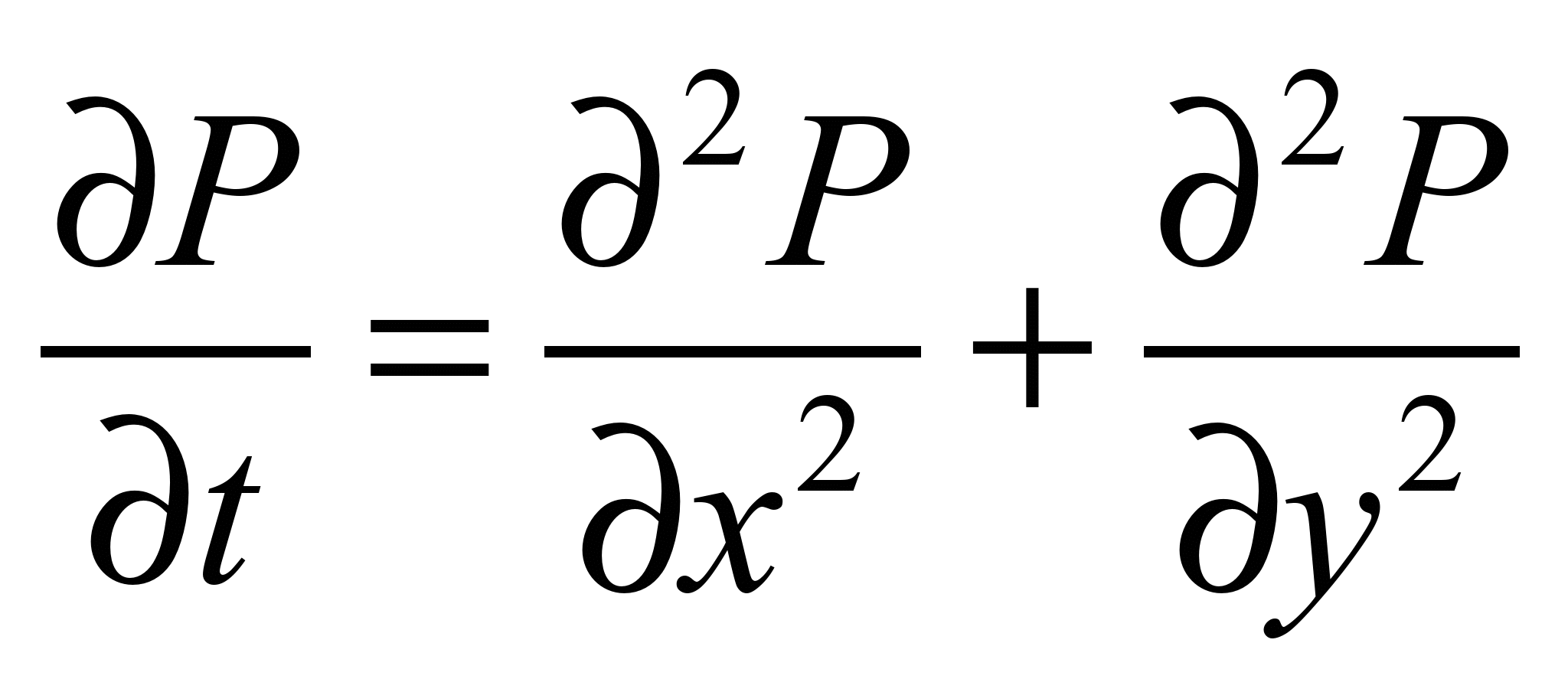 , (5)
, (5)
where t
– fictitious time (dimensionless).
It is known,
that when
 the solution of this equation will approach to the Laplace equation
solution for the velocity potential. To solve equation (5), it is
necessary to set “initial’ field of velocity in computational
region at t =
0. For example, before starting the calculation, you can set P
= 0 in the entire computational domain for t
= 0.
the solution of this equation will approach to the Laplace equation
solution for the velocity potential. To solve equation (5), it is
necessary to set “initial’ field of velocity in computational
region at t =
0. For example, before starting the calculation, you can set P
= 0 in the entire computational domain for t
= 0.
Numerical
integration of equation (5) is carried out on a rectangular grid.
Function P
is determined in the center of the difference cells.
Differential
scheme (Richardson’s method) for numerical integration of the
evolutional equation (5) is written as:


The unknown value of the
velocity potential is determined by the explicit running calculation
formula. The calculation is completed when the following condition
is fulfilled:
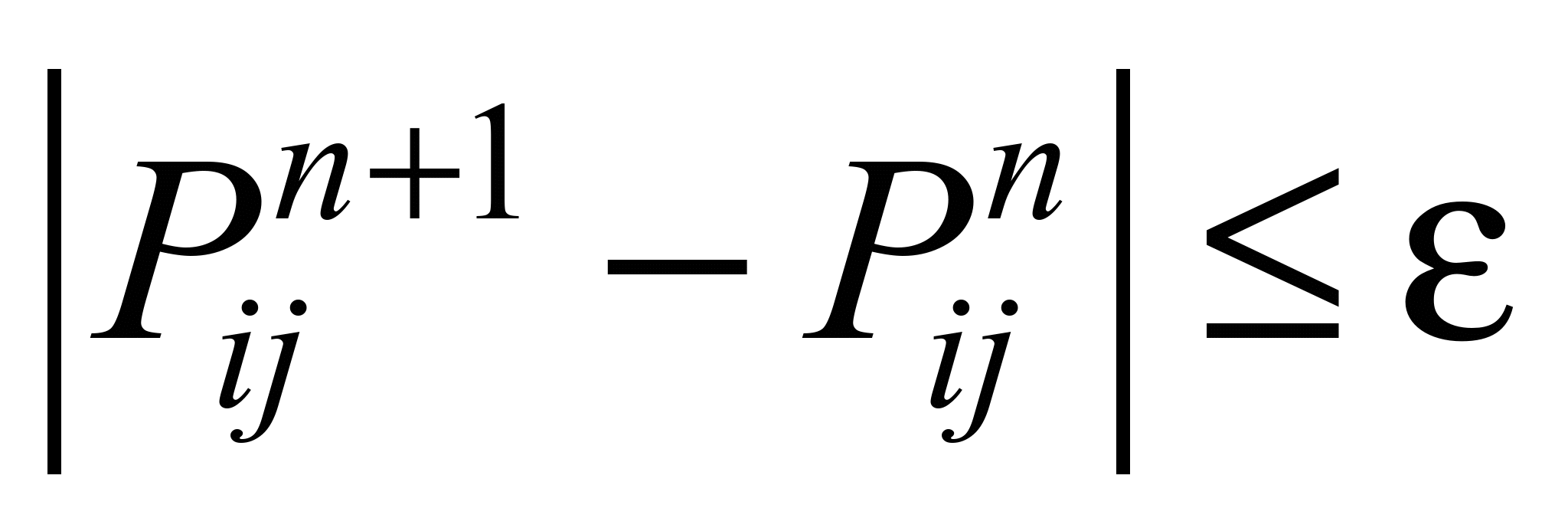 , (6)
, (6)
where ε
– is a small number (e.g., ε
=0.001); n
– iteration number.
After
determining the velocity potential field, the components of the air
velocity vector are calculated at the sides of the computational
cell using formulae:
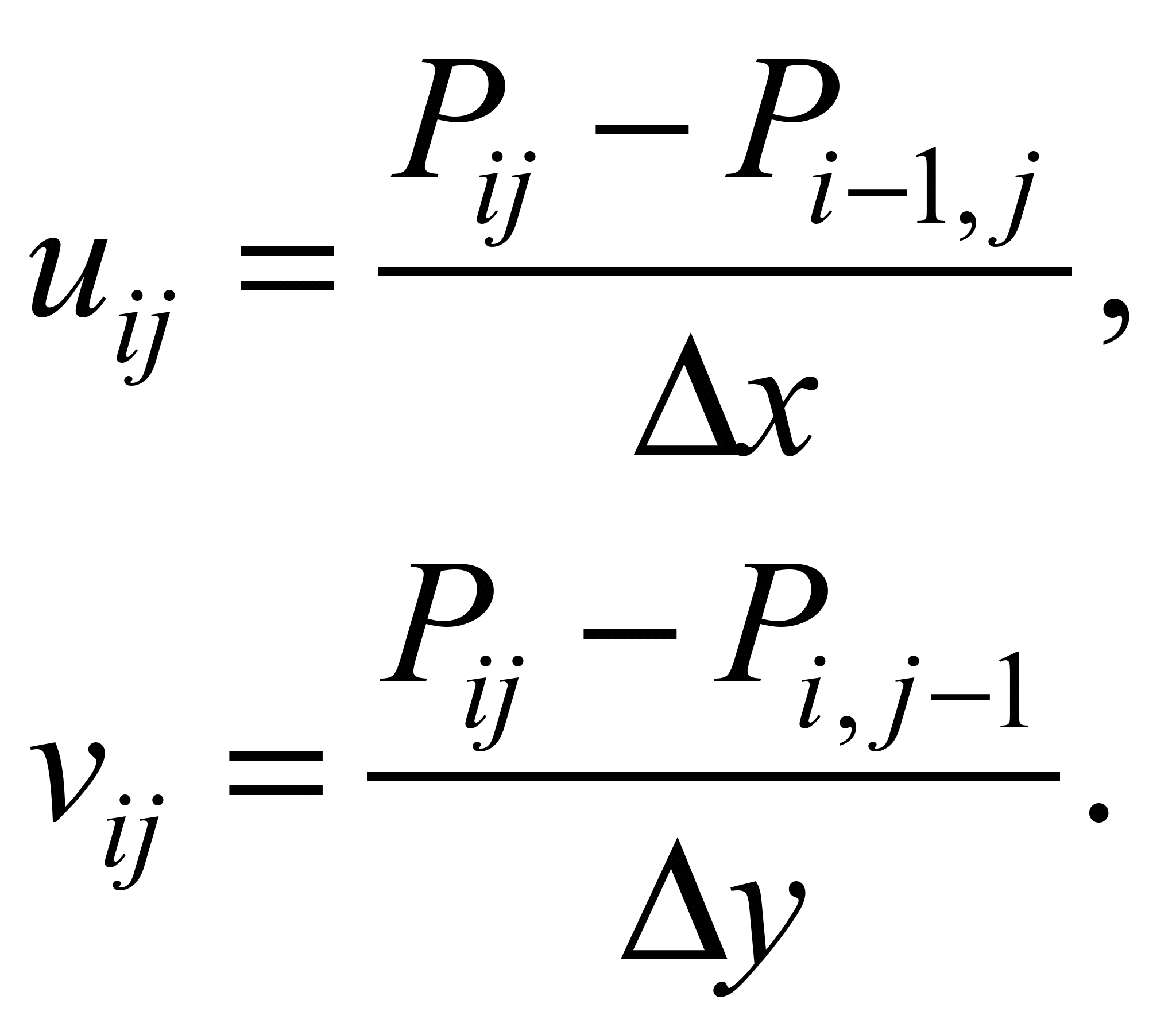
This approach to compute
velocity components on the sides of computational cells allows
constructing a conservative difference scheme for the mass transfer
equation.
For practice, it is extremely
important to reproduce the geometric form of the open pit mine. For
this, in the numerical model we used porosity technique (‘markers’
method). The computational domain is divided using a rectangular
difference grid (Figure 1). Using markers, we constructed open pit
mine boundaries. Using other markers, we constructed the initial
geometrical form of dust cloud in open pit mine. Other markers were
used to construct the geometrical form of obstacle near open pit
mine. This technique for computational region formation in numerical
model allows to change quickly this form during numerical
experiments. In Figure 1 the arrow indicates the wind direction.
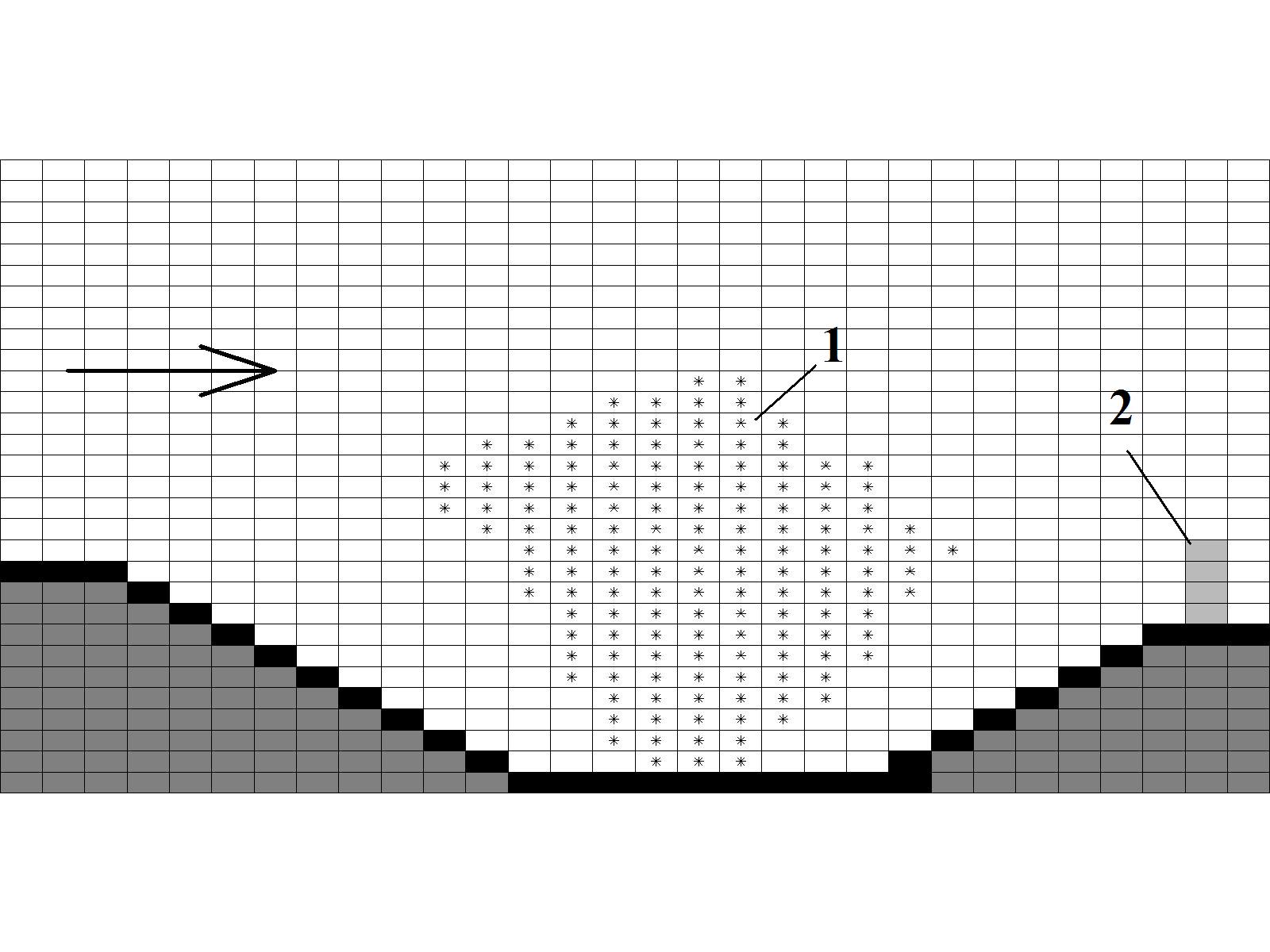
Fig.
1. Sketch of computational domain
scheme:
1
–
dust-gas cloud;
2 –
obstacle (trees position)
The developed numerical model
was coded using Fortran language.
Findings
Developed numerical model was
used to compute dust cloud movement in open pit mine.
To make all parameters
dimensionless, we have chosen the following scales [2]:
1)  is the wind velocity at the left boundary,
is the wind velocity at the left boundary,
 ;
;
2) 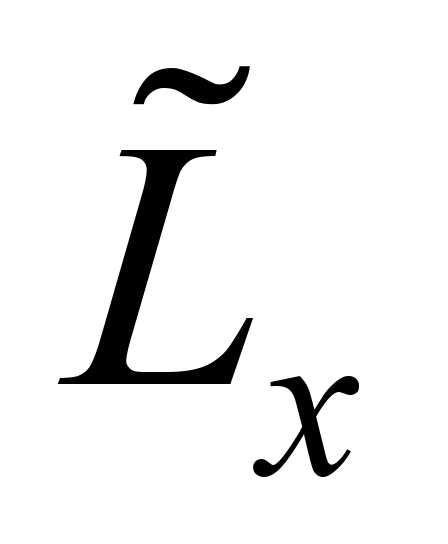 ,
m is the length of the computational domain;
,
m is the length of the computational domain;
3)  ,
μg·m-3 is the initial dust concentration
in the cloud for
,
μg·m-3 is the initial dust concentration
in the cloud for
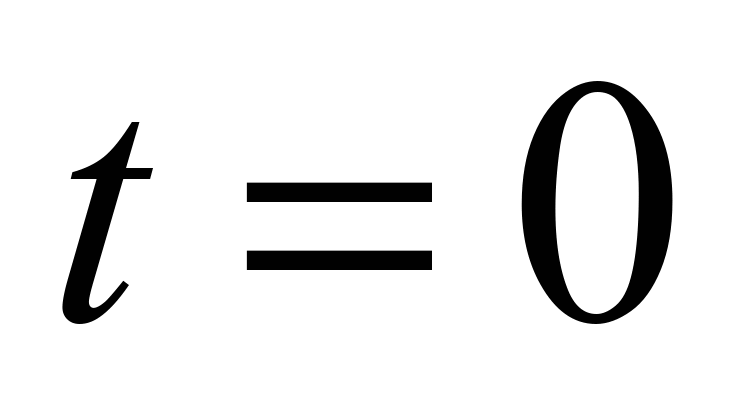 .
.
The dimensionless parameters
are calculated as follows:
 ,
where
,
where
 is time, s;
is time, s;
2) 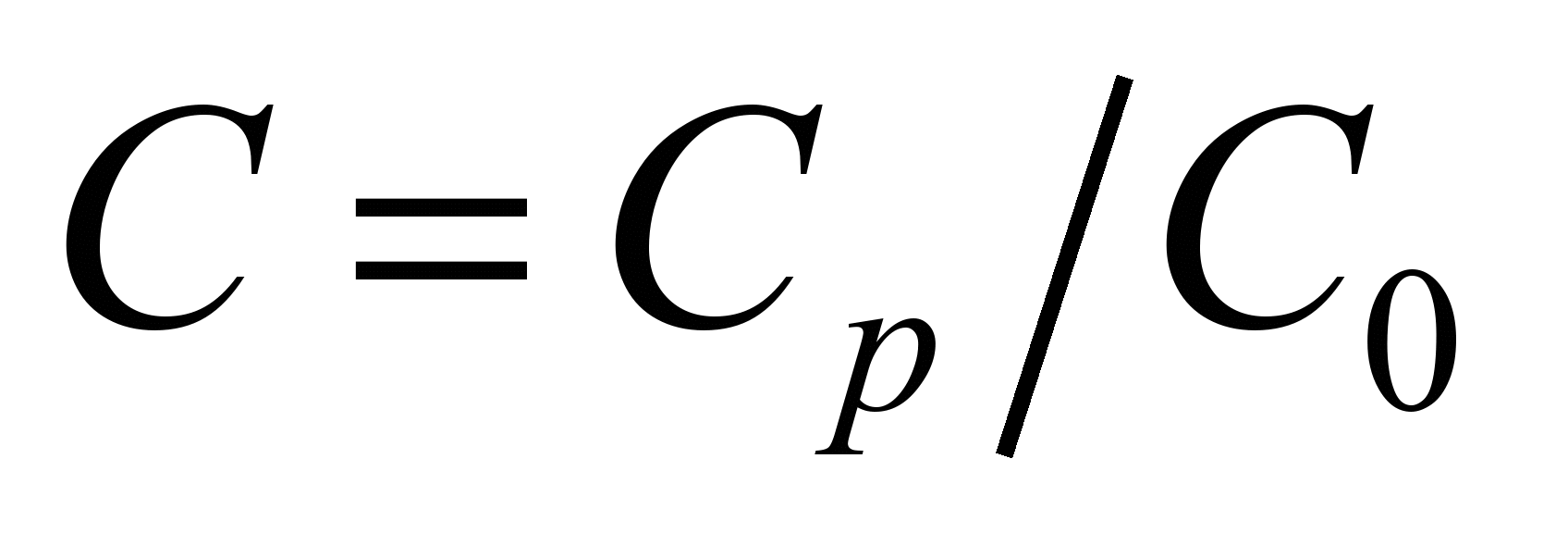 ,
where
,
where
 is dust concentration, μg·m-3;
is dust concentration, μg·m-3;
3) 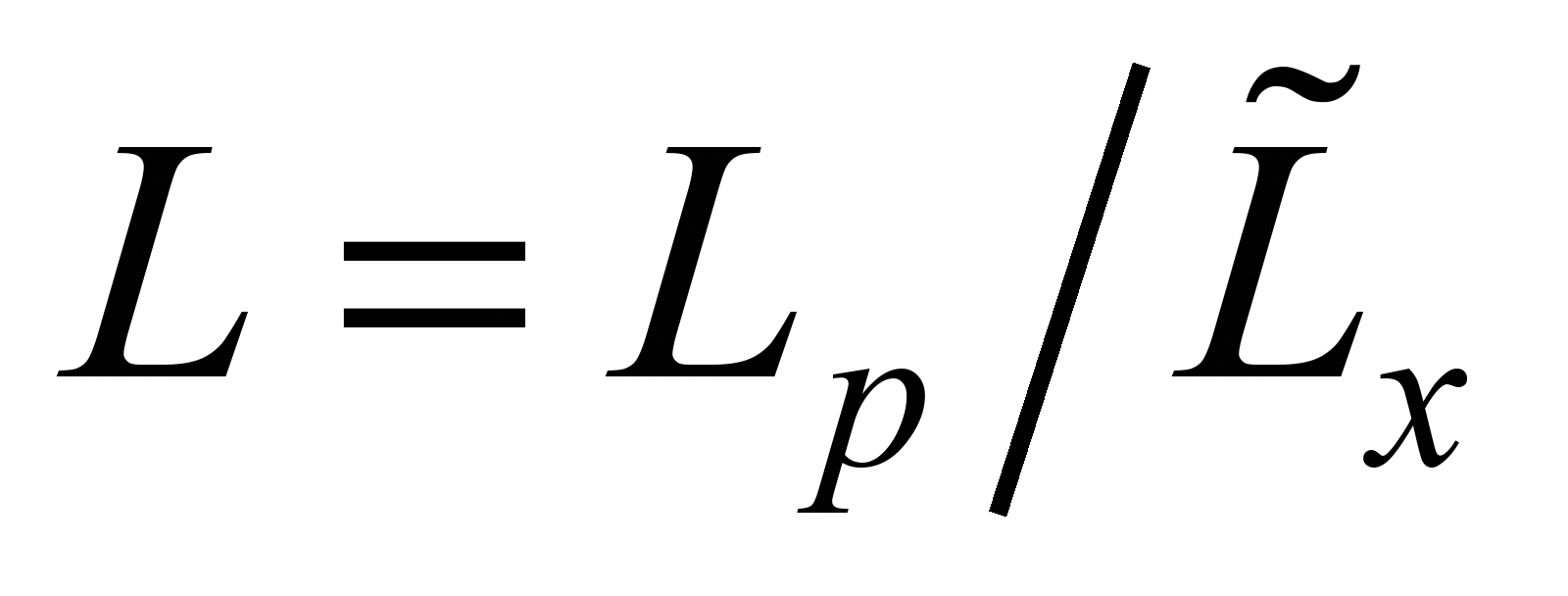 ,
where
,
where
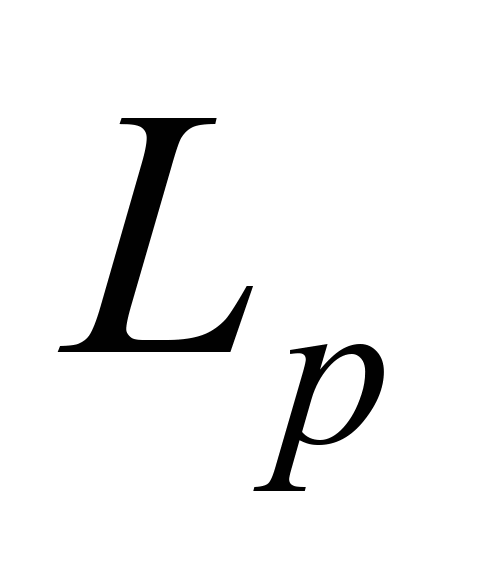 is length, m;
is length, m;
4) 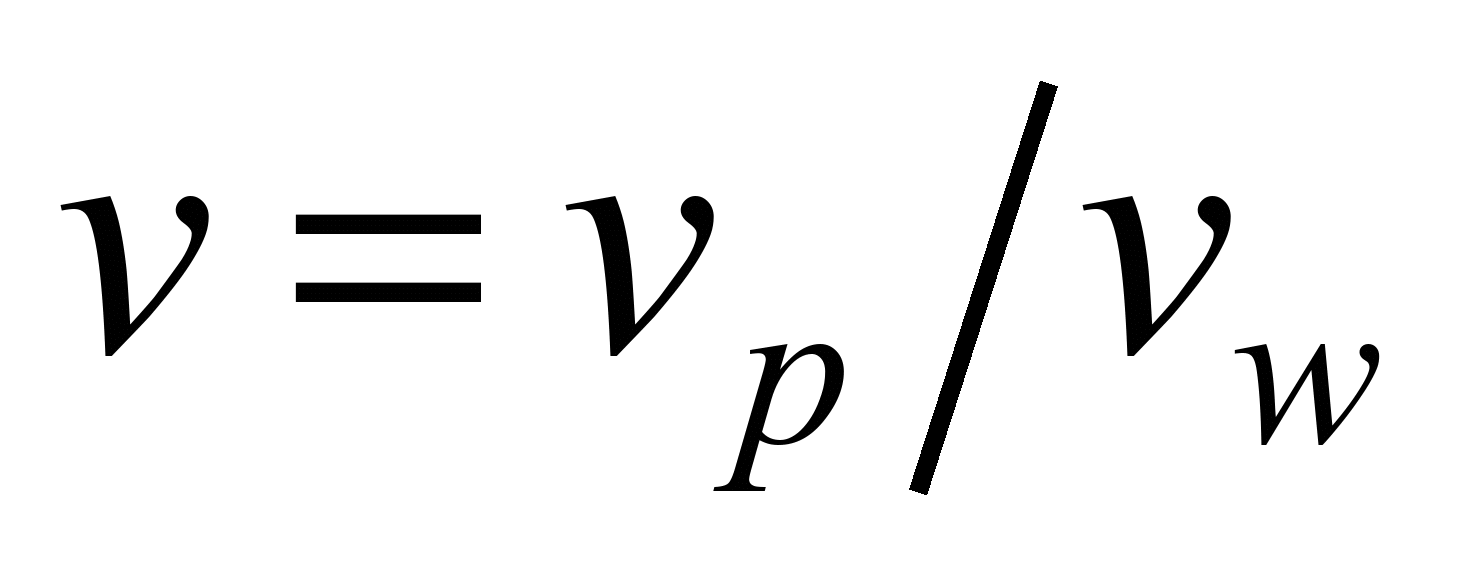 ,
where
,
where
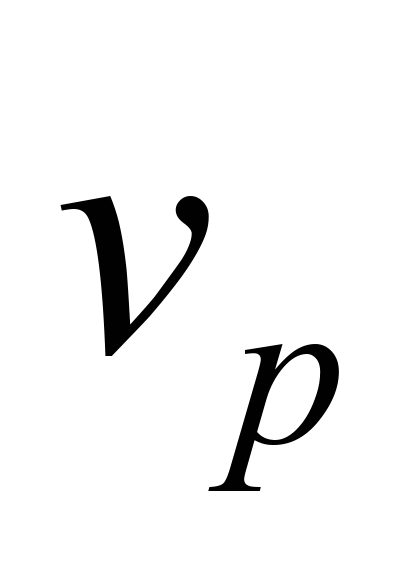 is local wind velocity, m/s.
is local wind velocity, m/s.
The length
of the computational domain is
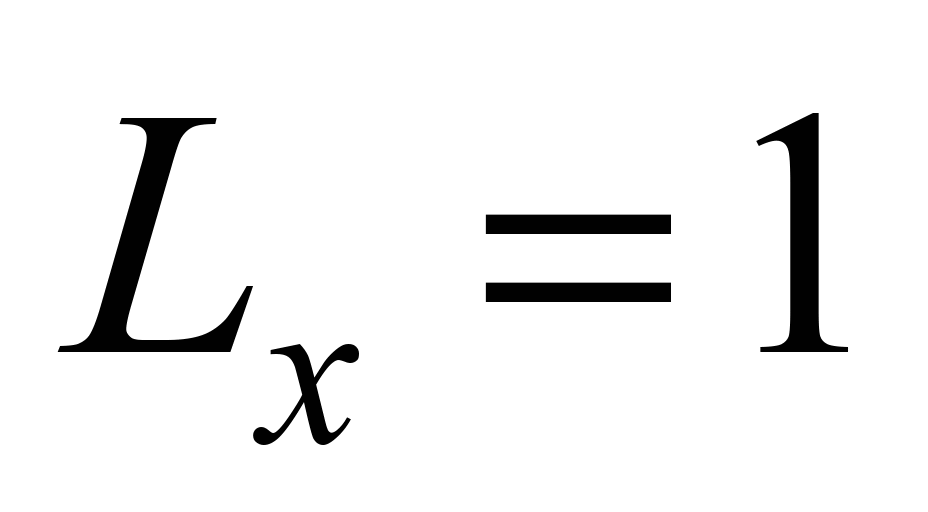 (dimensionless), the height of the computational domain is
(dimensionless), the height of the computational domain is
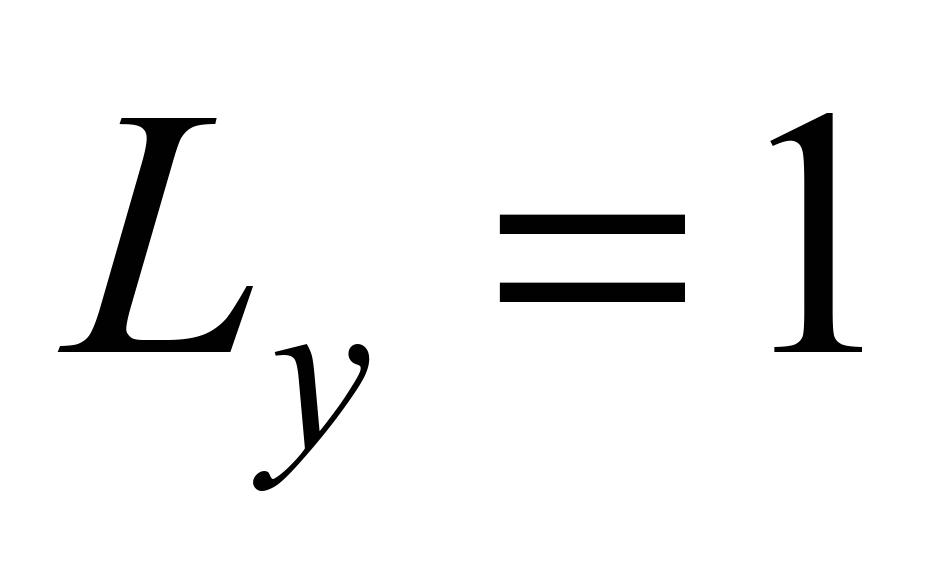 (dimensionless). The initial concentration of dust in the cloud is
(dimensionless). The initial concentration of dust in the cloud is
 (dimensionless) for
(dimensionless) for
 .
.
Figures 2-8 show dust
concentration field for different time after explosion in open mine.
In Figures 2-8 the arrow indicates the wind direction.
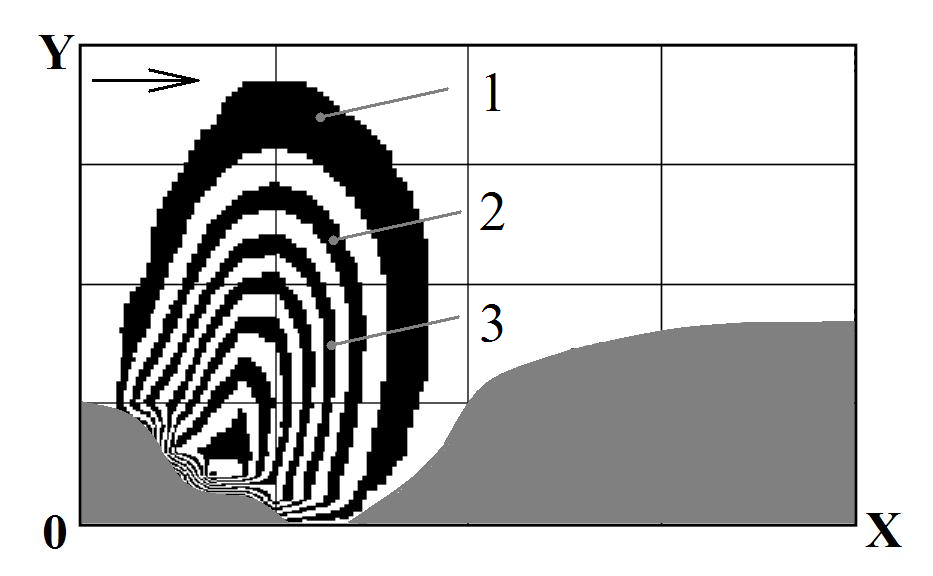
Fig.
2. Pollution zone: t=0.1 (time is
dimensionless):
1
– C=0.82;
2
– C=0.88;
3
– C=0.94
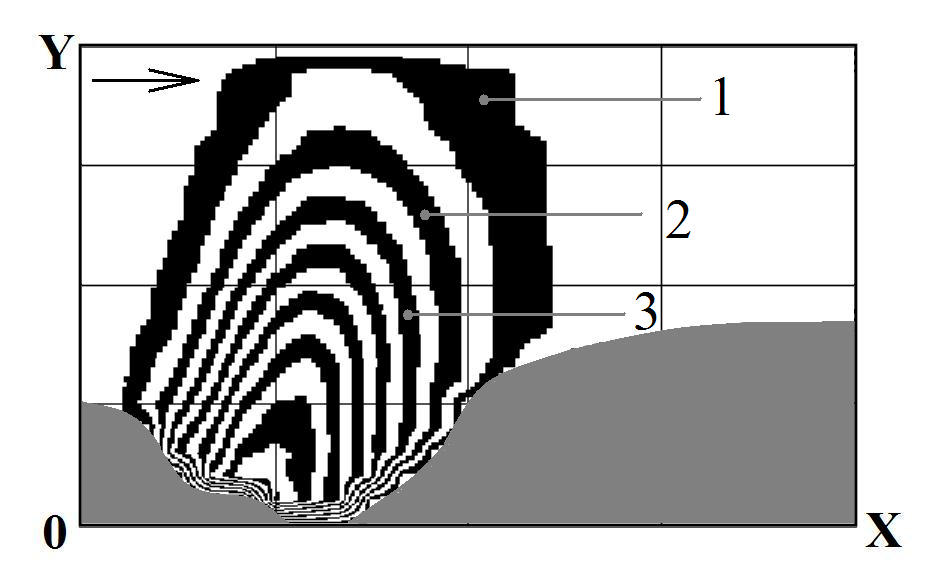
Fig.
3. Pollution zone: t=10
(time is dimensionless):
1
– C=0.67;
2
– C=0.73;
3
– C=0.81
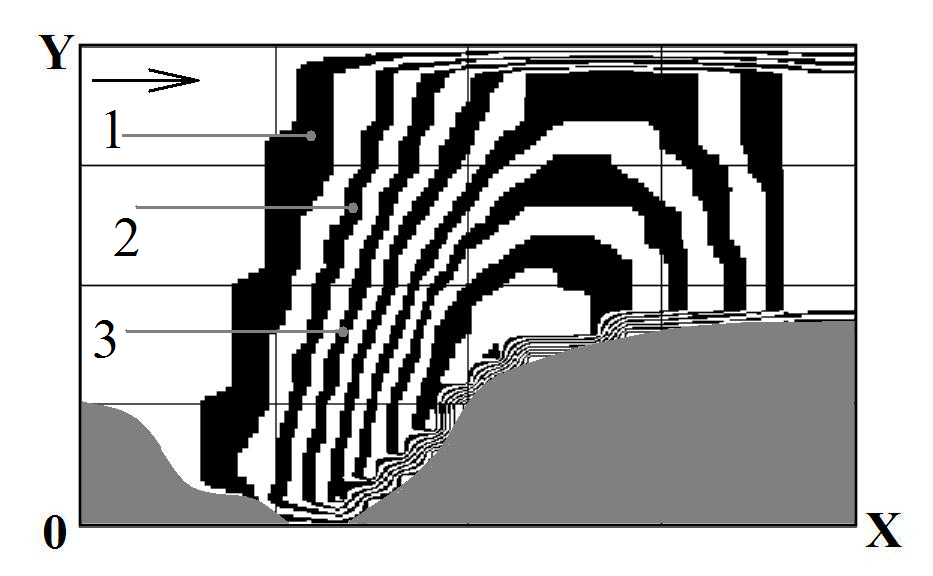
Fig.
4. Pollution zone: t=35
(time is dimensionless):
1
– C=0.51;
2
– C=0.59;
3
– C=0.64
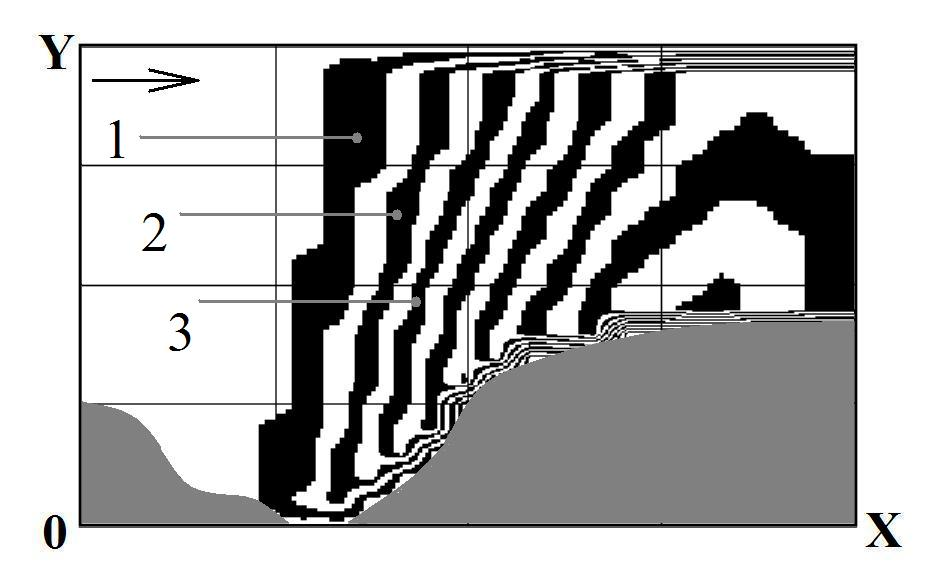
Fig.
5. Pollution zone: t=48
(time is dimensionless):
1
– C=0.42;
2
– C=0.48;
3
– C=0.55
From
Figures 2-5 we see deformation of dust cloud form in open pit mine.
This dust cloud is expanding during the time as a result of
atmospheric diffusion action.
Figures
6-8 show dust concentration field for different time after explosion
in open mine but when obstacle was introduced at one side of the
open pit mine.
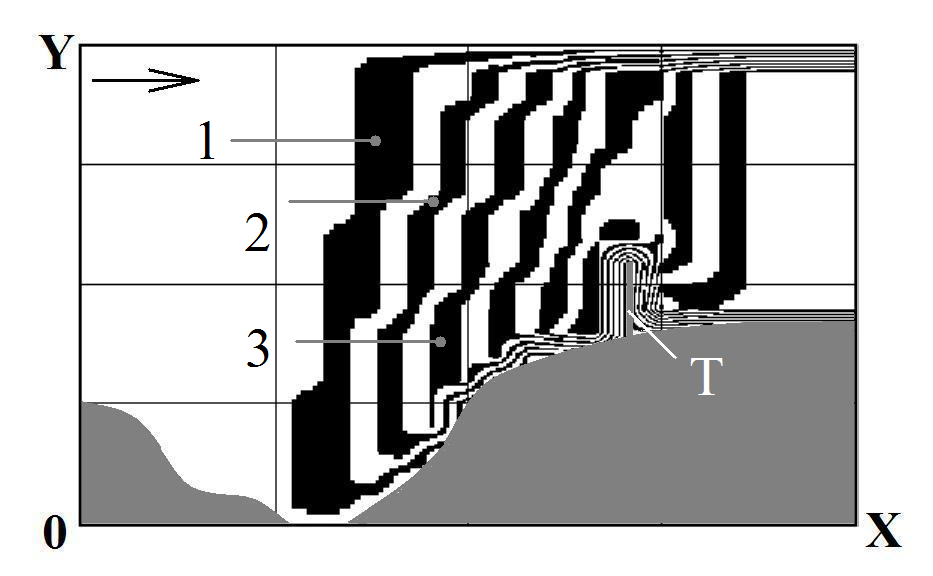
Fig.
6. Pollution zone: t=39
(time is dimensionless):
T –
obstacle, 1
– C=0.48;
2
– C=0.56;
3
– C=0.61
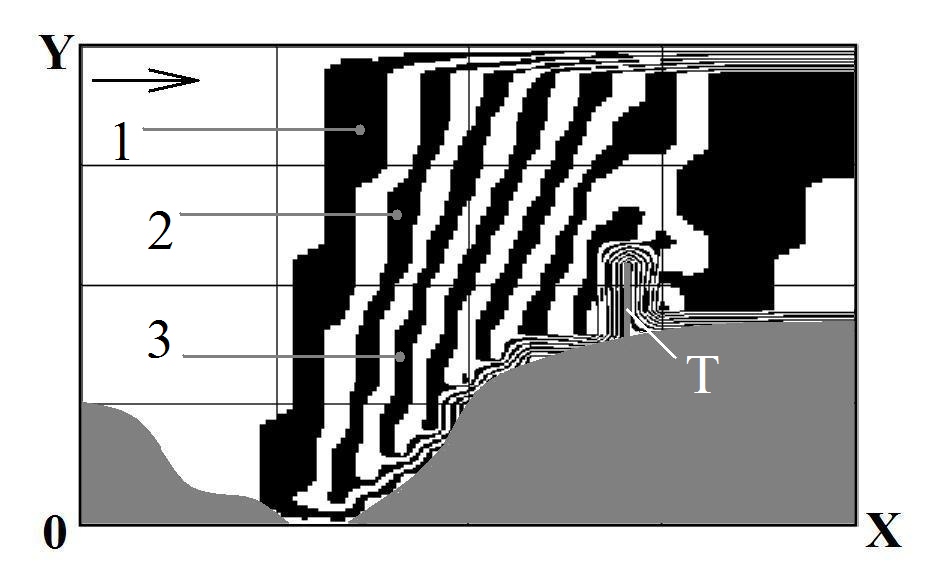
Fig.
7. Pollution zone: t=48
(time is dimensionless):
T
– obstacle, 1
– C=0.40;
2
– C=0.46;
3
– C=0.53
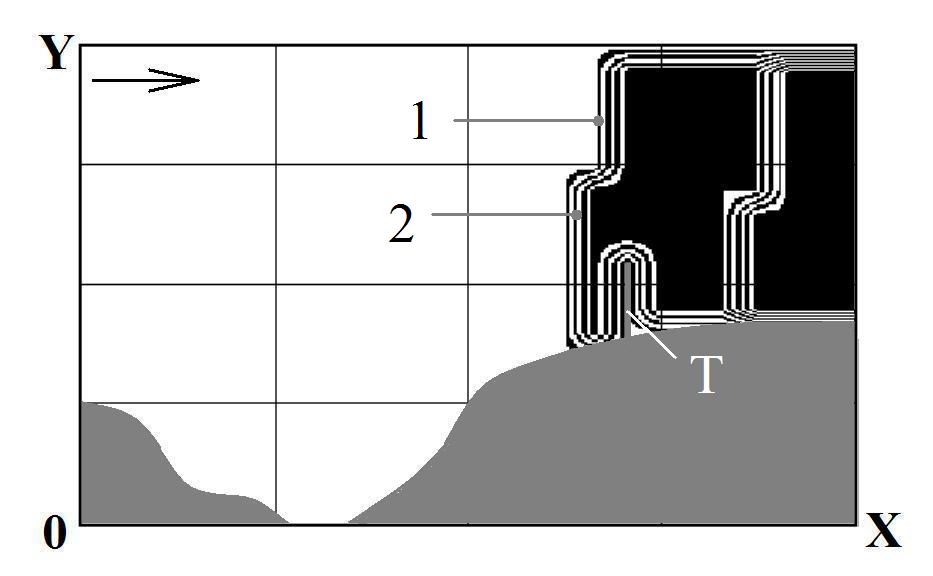
Fig.
8. Pollution zone: t=67
(time is dimensionless):
T
– obstacle, 1
– C=0.32;
2 –
C=0.41
Figures 6-8
illustrate the process of dust cloud diffraction on the obstaclе,
the height of the obstacle is L=0.2
(dimensionless). This
obstacle (see Figures 6-8, position T) simulates trees position near
the open pit mine [7].
Worthy of
note that computational time was 5 s.
Originality
and practical value
New numerical model was
developed to predict atmosphere pollution after blasts in open pit
mines. The model is based on equation of dust dispersion in the
atmosphere and equation for speed potential. To solve governing
equations difference schemes of splitting were used. Proposed
numerical model can be used for predictive calculations to assess
the impact of explosions in open pit mines on the environment.
Conclusions
In this
paper an effective numerical model for calculating the process of
atmospheric pollution after explosion in open pit mine was
developed. The model is based on the numerical integration of the
equation for the velocity potential and the Marchuk equation. The
difference schemes used have logical simplicity and convenient for
programming. The calculation of the process of atmospheric pollution
on the basis of the developed numerical model requires about 5
seconds of computer time. This allows to carry out serial
calculations within one working day. Further development of this
direction is associated with the creation of
a three-dimensional
numerical model of the atmospheric pollution process during
explosion in open pit mine.
LIST
OF REFERENCE LINKS
Алымов,
В. Т. Техногенный риск: Анализ и оценка
: учеб. пособие для вузов / В. Т. Алымов,
Н. П. Та-расова. – Москва : Академкнига,
2004. – 118 с.
Беляев,
Н. Н. Защита зданий от проникновения в
них опасных веществ : монография / Н.
Н. Беляев,
Е. Ю. Гунько, Н. В. Росточило.
– Днепропетровск : Акцент ПП, 2014. – 136
с.
Бересневич,
П. В. Аэрология карьеров : справочник
/ П. В. Бересневич, В. А. Михайлов, С. С.
Филатов. – Москва : Недра, 1991. – 280
с.
Оценка
техногенного риска при эмиссии опасных
веществ на железнодорожном транспорте
/ Н. Н. Бе-ляев, Е. Ю. Гунько, П. С. Кириченко,
Л. Я. Мунтян. – Кривой Рог : Р. А. Козлов,
2017. – 127 с.
Стоецкий,
В. Ф. Оценка риска при авариях техногенного
характера / В. Ф. Стоецкий, В. И. Голинько,
Л. В. Дранишников // Наук. вісн. НГУ. –
2014. – № 3. – С. 117–124.
Численное
моделирование распространения
загрязнения в окружающей среде / М. З.
Згуровский, В. В. Скопецкий, В. К. Хрущ,
Н. Н. Беляев. – Киев : Наук. думка, 1997. –
368 с.
Alvarez,
J. T. Dust
Barriers In
Open Pit
Blasts. Multiphase
Computational Fluid Dynamics (CFD) Simulations /
J.
T. Alvarez, I.
D. Alvarez, S.
T. Lougedo // WIT Transactions on Ecology
and the Environment. – 2008.
– 116 p.
Bai,
Y. Grey Mathematics Model for Atmospheric Pollution Based on
Numerical Simulation / Y. Bai // Chem-ical Engineering
Transactions. – 2018. – Vol. 71. – P. 679–684. doi:
10.3303/CET1871114
Berlov,
O. V. Atmosphere protection in case of emergency during
transportation of dangerous cargo / O. V. Berlov // Наука
та прогрес
транспорту. – 2016. – № 1
(61). – С. 48–54. doi:
10.15802/stp2016/60953
Biliaiev,
M. M. Numerical Simulation of Indoor Air Pollution and Atmosphere
Pollution for Regions Having Complex Topography / M. M. Biliaiev,
M. M. Kharytonov // NATO Science for Peace and Security. Series C:
Environmental Security. – Dordrecht, 2012. – P. 87–91. doi:
10.1007/978-94-007-1359-8_15
Cefic
Guidance on safety Risk Assessment for Chemical Transport
Operations [Electronic resource] / Croner-i. – Available at:
http://clc.am/OnkmUw – Title from the screen. – Accessed :
29.03.2019.
Effect
of barriers on the status of atmospheric pollution by mathematical
modeling / Z. Naserzadeh, F. Atabi, F. Moattar, N. M. Nejad //
Bioscience Biotechnology Research Communications.
– 2017. – Vol. 10 (1). – P. 192–204.
Oyjinda,
P. Numerical Simulation to Air Pollution Emission Control near an
Industrial Zone / P. Oyjinda, N. Pochai // Advances in
Mathematical Physics. – 2017. – Vol. 2017. – P. 1–7. doi:
10.1155/2017/5287132
Protective
Action Criteria. A Review of Their Derivation, Use, Advantages and
Limitations [Electronic resource] // Environmental Public Health
Science Unit, Health Protection Branch, Public Health and
Compli-ance Division, Alberta Health. – Edmonton, Alberta, 2017.
– Available at: http://open.alberta.ca/publications/9781460131213
– Title from the screen. – Accessed : 23.04.2019.
The
analysis of the use of mathematical modeling for emergency planning
purposes [Electronic resource] / O. Zavila, P. Dobes, J.
Dlabka, J. Bitta // The science for population protection. –
2015. – № 2. – Available at:
http://www.population-protection.eu/prilohy/casopis/eng/22/112.pdf
– Title from the screen. – Accessed : 23.04.2019.
В. В. БІЛЯЄВа1*,
п. с.
кіріченко2*,
О. В. Берлов3*,
в. о.
габрінець4*,
В.
м. горячкін5*
1*Каф.
«Аерогідромеханіка та енергомасоперенос»,
Дніпровський національний
університет
імені Олеся Гончара, пр.
Гагаріна, 72, Дніпро, Україна, 49000,
тел.
+38 (056) 374 98 22, ел. пошта
water.supply.treatment@gmail.com,
ORCID
0000-0003-2399-3124
2*Каф. «Теплогазопостачання,
водовідведення та вентиляція»,
Криворізький
національний університет,
вул. Віталія Матусевича,
11, Кривий Ріг, Україна,
50027, тел. +38 (056)
409 06 06, ел. пошта pasha_129@ukr.net,
ORCID 0000-0002-0793-9593
3*Каф.
«Безпека життєдіяльності», Придніпровська
державна академія
будівництва та
архітектури, вул. Чернишевського, 24а,
Дніпро, Україна,
49600, тел. +38 (056) 756 34 57,
ел. пошта
berlov@pgasa.dp.ua,
ORCID 0000-0002-7442-0548
4*Каф.
«Теплотехніка», Дніпровський національний
університет залізничного
транспорту
імені академіка В. Лазаряна, вул.
Лазаряна, 2, Дніпро, Україна,
49010, тел.
+38 (056) 373 15 87, ел. пошта gabrin62@gmail.com,
ORCID
0000-0002-6115-7162
5*Каф.
«Теплотехніка», Дніпровський національний
університет залізничного
транспорту
імені академіка В. Лазаряна, вул.
Лазаряна, 2, Дніпро, Україна,
49010, тел.
+38 (056) 373 15 87, ел. пошта vgora@ukr.net,
ORCID
0000-0002-8952-952X
КОМП'ЮТЕРНЕ
МОДЕЛЮВАННЯ забруднення
атмосферного
повітря ПІД ЧАС руХУ
пилової хмари В
кар'єрі
Мета.
Вибухи в кар’єрах призводять до
утворення пилових хмар, які інтенсивно
забруднюють атмосферне повітря. Метою
цієї роботи є розробка чисельної моделі
для прогнозування забруднення атмосфери
після вибуху в кар’єрі. Така чисельна
модель повинна під час розрахунку
враховувати геометричну форму кар'єру,
параметри метеорологічної ситуації
(швидкість вітру, стан атмосфери), форму
пилової хмари, що утворюється в кар’єрі
на місці вибуху. Методика.
Математичне моделювання розсіювання
пилової хмари під час вибуху в кар’єрі
ґрунтується на використанні фундаментальних
рівнянь аеродинаміки й масопереносу.
Поле швидкості повітряного потоку в
кар’єрі моделюється за допомогою
рівняння Лапласа для потенціалу
швидкості. Формування концентраційного
поля пилу моделюється на основі рівняння
конвективно-дифузійного розсіювання
домішки. Для чисельного інтегрування
моделювальних рівнянь використано
різницеві схеми. Рівняння Лапласа для
потенціалу швидкості чисельно
інтегрується за допомогою методу
Річардсона. Для чисельного інтегрування
рівняння конвективно-дифузійного
розсіювання домішки використано неявну
різницеву схему розщеплення. Результати.
Розроблено CFD – модель, яка дозволяє
виконати розрахунок формування зон
забруднення під часу руху пилової хмари
в кар’єрі. Особливістю розробленої
моделі є швидкість розрахунку. Для її
практичного використання необхідна
стандартна вхідна інформація. Наукова
новизна. На відміну
від наявних в Україні моделей, розроблена
чисельна модель дозволяє враховувати
геометричну форму кар’єра й геометричну
форму пилової хмари для проведення
прогнозних розрахунків з оцінки рівня
забруднення атмосферного повітря під
час вибухів у кар’єрах. Практична
значимість. Розроблена
чисельна модель може бути імплементована
на комп’ютерах малої й середньої
потужності використанням стандартної
інформації про метеоумови в кар’єрі.
Цю модель можна використовувати для
екологічної оцінки впливу вибухів у
кар’єрі на забруднення навколишнього
середовища й робочих зон.
Ключові слова:
пилова хмара; кар’єр; забруднення
атмосфери; комп'ютерне моделювання
В. В. БЕЛЯЕВА1*, П. С. КИРИЧЕНКО2*,
А. В. БЕРЛОВ3*, В.
А. ГАБРИНЕЦ4*,
В.
Н. ГОРЯЧКИН5*
1*Каф.
«Аэрогидромеханика и энергомассопереноса»,
Днипровский национальный
университет
имени Олеся Гончара, пр. Гагарина,
72, Днипро, Украина, 49000,
тел. +38 (056) 374 98
22, эл. почта water.supply.treatment@gmail.com,
ORCID
0000-0003-2399-3124
2*Каф.
«Теплогазоснабжение, водоотведение и
вентиляция», Криворожский
национальный
университет, ул. Виталия Матусевича,
11, Кривой Рог,
Украина, 50027, тел. +38 (056)
409 06 06, эл. почта pasha_129@ukr.net,
ORCID
0000-0002-0793-9593
3*Каф.
«Безопасность жизнедеятельности»,
Приднепровская государственная
академия
строительства и архитектуры,
ул. Чернышевского, 24а, Днипро,
Украина,
49600, тел. +38 (056) 756 34 57, эл. почта
berlov@pgasa.dp.ua,
ORCID 0000-0002-7442-0548
4*Каф.
«Теплотехника», Днипровский национальный
университет
железнодорожного транспорта
имени академика В. Лазаряна, ул.
Лазаряна, 2,
Днипро, Украина, 49010, тел.
+38 (056) 373 15 87, эл. почта gabrin62@gmail.com,
ORCID
0000-0002-6115-7162
5*Каф.
«Теплотехника», Днипровский национальный
университет железнодорожного
транспорта
имени академика В. Лазаряна, ул.
Лазаряна, 2, Днипро, Украина,
49010, тел.
+38 (056) 373 15 87, эл. почта vgora@ukr.net,
ORCID
0000-0002-8952-952X
КОМПЬЮТЕРНОЕ
МОДЕЛИРОВАНИЕ
ЗАГРЯЗНЕНИЯ АТМОСФЕРНОГО
ВОЗДУХА ПРИ ДВИЖУЩЕМСЯ
ПЫЛЕВОМ ОБЛАКЕ
В КАРЬЕРЕ
Цель. Взрывы
в карьерах приводят к образованию
пылевых облаков, которые интенсивно
загрязняют атмосферный воздух. Целью
данной работы является разработка
численной модели для прогнозирования
загрязнения атмосферы после взрыва в
карьере. Эта численная модель должна
при расчете учитывать геометрическую
форму карьера, параметры метеорологической
ситуации (скорость ветра, состояние
атмосферы), форму пылевого облака,
которое образуется в карьере на месте
взрыва. Методика.
Математическое
моделирование рассеивания пылевого
облака при взрыве в карьере основывается
на использовании фундаментальных
уравнений аэродинамики и массопереноса.
Поле скорости воздушного потока в
карьере моделируется с помощью уравнения
Лапласа для потенциала скорости.
Формирование концентрационного поля
пыли моделируется на базе уравнения
конвективно-диффузионного рассеивания
примеси. Для численного интегрирования
моделирующих уравнений использованы
разностные схемы. Уравнение Лапласа
для потенциала скорости численно
интегрируется с помощью метода
Ричардсона. Для численного интегрирования
уравнения конвективно-диффузионного
рассеивания примеси использована
неявная разностная схема расщепления.
Результаты. Разработана
CFD – модель, которая позволяет выполнить
расчет формирования зон загрязнения
при движении пылевого облака в карьере.
Особенностью разработанной модели
является быстрота расчета. Для её
практического использования необходима
стандартная входная информация. Научная
новизна. В отличие от
существующих в Украине моделей,
разработанная численная модель
позволяет учитывать геометрическую
форму карьера и геометрическую форму
пылевого облака для проведения прогнозных
расчетов по оценке уровня загрязнения
атмосферного воздуха при взрывах в
карьерах. Практическая
значимость. Разработанная
численная модель может быть имплементирована
на компьютерах малой и средней мощности
с использованием стандартной информация
о метеоусловиях в карьере. Эту модель
можно использовать для экологической
оценки влияния взрывов в карьере на
загрязнение окружающей среды и рабочих
зон.
Ключевые
слова:
пылевое
облако; карьер; загрязнение атмосферы;
компьютерное моделирование
References
Alymov, V. T., & Tarasova, N.
P. (2004). Tekhnogennyy risk: Analiz i
otsenka: Uchebnoe posobie dlya vuzov. Moscow:
Akademkniga. (in Russian)
Biliaiev,
N. N., Gunko, E. Y., & Rostochilo, N. V. (2014). Zashchita
zdaniy ot proniknoveniya v nikh opasnykh veshchestv: Monografiya.
Dnepropetrovsk: Aktsent PP. (in Russian)
Beresnevich,
P. V., Mikhaylov, V. A., & Filatov, S. S. (1991). Aerologtya
karerov: spravochnik. Moskva: Nedra.
(in Russian)
Biliaiev,
N. N., Gunko, E. Y., Kirichenko, P. S., & Muntian, L. Y.
(2017). Otsenka tekhnogennogo riska
pri emissii opasnykh veshchestv na zheleznodorozhnom transporte.
Krivoy Rog: Kozlov R. A. (in Russian)
Stoetsky,
V. F., Golinko, V. I., & Dranishnikov, L. V. (2014). Risk
assessment in man-caused accidents. Sci-entific Bulletin
of National Mining University, 3, 117-124. (in Russian)
Zgurovskiy,
M. Z., Skopetskiy, V. V., Khrushch, V. K., & Biliaiev, N. N.
(1997). Chislennoe modelirovanie
rasprostraneniya zagryazneniya v okruzhayushchey srede.
Kyiv: Naukova dumka. (in Russian)
Alvarez,
J. T., Alvarez, I. D., & Lougedo,
S. T. (2008).
Dust Barriers in Open Pit Blasts.
Multiphase Computational Fluid Dynamics (CFD) Simulations.
WIT Transactions on Ecology and the
Environment. (in English)
Bai,
Y. (2017). Grey Mathematics Model for Atmospheric Pollution Based
on Numerical Simulation. Chemi-cal
Engineering Transactions, 71,
679-684. doi: 10.3303/CET1871114 (in English)
Berlov,
O. V. (2016). Atmosphere protection in case of emergency during
transportation of dangerous cargo. Science
and Transport Progress, 1(61), 48-54.
doi: 10.15802/stp2016/60953 (in English)
Biliaiev,
M. M., & Kharytonov, M. M. (2012). Numerical Simulation of
Indoor Air Pollution and Atmosphere Pollution for Regions Having
Complex Topography. NATO Science for
Peace and Security. Series C: Envi-ronmental Security.
Dordrecht. doi: 10.1007/978-94-007-1359-8_15
(in English)
Cefic
Guidance on safety Risk Assessment for Chemical Transport
Operations. Croner-i. Retrieved
from http://clc.am/OnkmUw (in English)
Naserzadeh,
Z., Atabi, F., Moattar, F., & Nejad, N. M. (2017). Effect of
barriers on the status of atmospheric pollution by mathematical
modeling. Bioscience Biotechnology
Research Communications, 10(1), 192-204.
(in English)
Oyjinda,
P., & Pochai, N. (2017). Numerical Simulation to Air Pollution
Emission Control near an Industrial Zone. Advances
in Mathematical Physics, 2017, 1-7. doi:
10.1155/2017/5287132 (in English)
Government
of Alberta. (2017). Protective Action Criteria: A Review of Their
Derivation, Use, Advantagesand Limitations. Environmental Public
Health Science Unit, Health Protection Branch, Public Health and
Compliance Division, Alberta Health. Edmonton, Alberta. Retrieved
from http://open.alberta.ca/publications/9781460131213 (in
English)
Zavila,
О., Dobes, Р.,
Dlabka, J., & Bitta, J. (2015). The analysis of the use of
mathematical modeling foremergency planning purposes. The
Science for Population Protection, 2. Retrieved
from
http://www.population-protection.eu/prilohy/casopis/eng/22/112.pdf
(in English)
Received:
March 18, 2019
Accepted:
July 26, 2019
, (1)
(2)
– are turbulent
diffusion
coefficients, m2·s-1,
x, y
– are Cortesian coordinates, m; σ – coefficient of pollutant
chemical decay, s-1.
(3)
(4)
, (5)
the solution of this equation will approach to the Laplace equation
solution for the velocity potential. To solve equation (5), it is
necessary to set “initial’ field of velocity in computational
region at t =
0. For example, before starting the calculation, you can set P
= 0 in the entire computational domain for t
= 0.
, (6)
is the wind velocity at the left boundary,
;
,
m is the length of the computational domain;
,
μg·m-3 is the initial dust concentration
in the cloud for
.
, where
is time, s;
,
where
is dust concentration, μg·m-3;
,
where
is length, m;
,
where
is local wind velocity, m/s.
(dimensionless), the height of the computational domain is
(dimensionless). The initial concentration of dust in the cloud is
(dimensionless) for
.